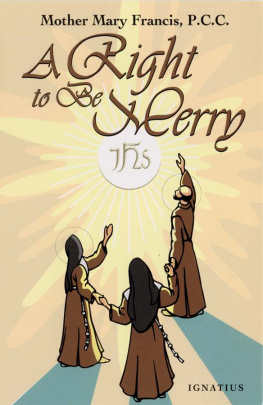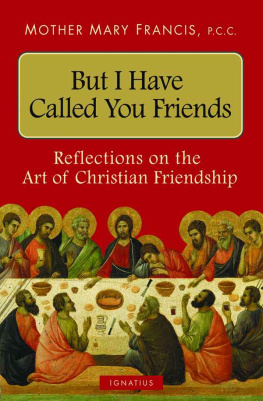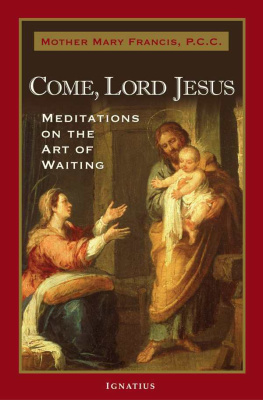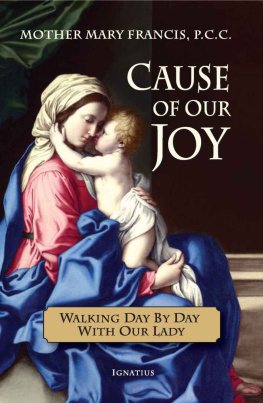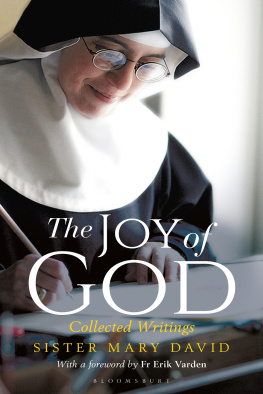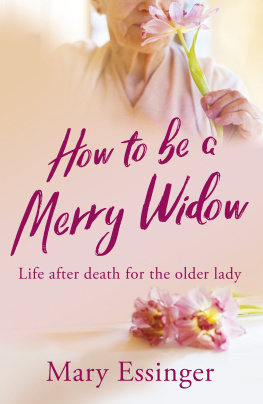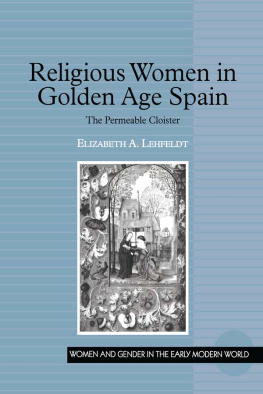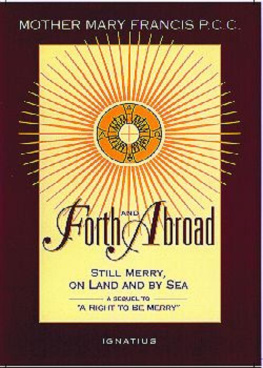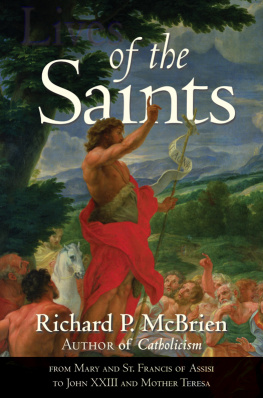A RIGHT TO BE MERRY
MOTHER MARY FRANCIS, P. C.C.
A RIGHT
TO BE MERRY
IGNATIUS PRESS SAN FRANCISCO
Original edition published in 1956
by Sheed & Ward, New York
1973, Franciscan Herald Press, Chicago
All rights reserved
Published with ecclesiastical permission
New edition printed by permission
Cover art by Christopher J. Pelicano
Cover design by Riz Boncan Marsella
based on an original drawing by a Poor Clare sister
New edition 2001, Ignatius Press, San Francisco
All rights reserved
ISBN 978-0-89870-824-0
Library of Congress control number 2001088860
Printed in the United States of America
To His Excellency, Most Reverend Edwin V Byrne, D. D.
and
Reverend Mother Mary Immaculata
our first abbess and cherished mother
Our Lord told Margery Kempe, the anchoress of Lynn, that her enclosed life of union with Him gave Him the greatest satisfaction, and it gave her as great a right to be merry as any lady in the world.
AUTHORS NOTE
The names of cloistered nuns and postulants used in this book are fictitious. Nothing else is.
CONTENTS
PREFACE
POST VATICAN II
We are hearing and talking a great deal about options these days. So, here are two options for you, and an opportunity to exercise your keen sense of personal autonomy. Make up your own mind. Follow your conscience. Read the following as: (i) a prologue to this reprinting of A Right to Be Merry; or, (2) an epilogue to same. But, then, we just knew someone would be dissatisfied with the options allowed. So, all right, go ahead. Read it in the middle of the book. Or, do not read it at all, if you are a conscientious objector to anything that is proposed.
Still Merry
Expertise is what we are after today. Nature has it in the sensitive area of death. She performs it like a Greek drama, with all the dignity of the inevitable freely chosen. Yet she dances it like an innocent child ballerina, spilling out the story with the effortless abandon of pure dedication. Again, she does it as purposefully as Francis of Assisi, who sang because he had nothing left on earth and had found a Father in Heaven. She knows all about the return of spring and what makes that return possible.
And so, for a chapter penance (since we still have chapter and still do penance), each nun and novice was asked last week to go outdoors and take a lesson in dying and resurrection from nature. It was suggested (by which we mean: Go ahead and do it!) that each one take spiritual notes on dying from what God has to say in nature. A few main points were anticipated, such as: dying ungrudgingly, gloriously, gorgeously, gaily. Because this is the way to live. And because somewhere along the theological way of the present wonderful new emphasis on resurrection, some of us seem to have forgotten how one arrives at resurrection. How Christ did. That it was and it is through suffering and death. Odd, how we can miss such an obvious fact as that we have to die before we can rise from the dead.
Since a handful of us started Poor Clare living in an old farmhouse in Roswell in November 1948, an ecumenical council has set itself down in history, even though one could scarcely say that it has settled itself down in history. Reading the luminous council documents, inhaling all the freshness of challenge and positive change which they inspire, it is painful to witness the wrangling and rebellion and disintegration that are assuredly non sequiturs of Vatican IIs intentions. Yet, there are many ways of dying. And we here in Squash Valley (our present recreational tag for our monastic estate, because squash doth thrive right mightily in the cloister vegetable garden) continue to believe in life and in springtime.
There are thirty-one of us here in Roswell now, besides the five nuns we have dispatched to shore up a monastery in need. And since twenty-two of the thirty-six of us are in their twenties, it would be exceedingly difficult not to believe in springtime. The gentle foundress of our monastery, to whom this book was and is dedicated, has gone before us to set up a new foundation in eternity. And Archbishop Byrne is with her there. Last February, we placed Mother Immaculata in the center niche of our burial vault, beside our first vicaress, she of the two-toned habit (see chapter 11). And new life springs out of the beauty of their dying. Many little customs in our life-style have been changed, because this kind of dying is part of living. No essentials have been changed, because things fundamental do not become obsolescent, though they can be given new expressions.
We are still wearing our religious habits and veils, and we would as soon take off our skin as our Franciscan garb. Hemlines are a dashing four inches from the floor (saves on the mending) and enclosure veils (see chapter i) are no longer worn. Theres a single screen in the parlor instead of a double grille, because screen is just as valid a symbol of our enclosed contemplative life, and is cheaper besides. The priest has been facing us people since our monastery was built, so we can only be delighted that the whole Church is now in accord with us.
Anything else new? How about dialogue and community discussions? Well, we believe that dialogue with God, with our founders, with one another is essential, and we have never believed any differently. We have a community discussion whenever there is something to discuss. When there is nothing to discuss, we do not have a discussion. We live the simple life.
Ecumenism? A Methodist minister has given us some splendid conferences. A few months ago, eight young ex-drug addicts, none of them Catholic, rang our doorbell and told us that they wanted to play and sing for us. So, they sat on our parlor floor and played and sang; and we sat behind our enclosure screen and sang to them. We loved these sincere young people. And they said to us: Were home, here! That made us very happy.
Because the publisher has earnestly pointed out to me that changes in printed text are very expensive to make, I have tried to show myself alert to that reality by broadly outlining here what is the same (everything important) and what is different (many little things) since 1956. Dying is part of living. The sloughing off of outmoded practices belongs to the life process and should not occasion any contempt for the past. After all, we have a present only because we have a past. And we build a future only by living in the present. Leaf-shedding is not an autumnal entity, nor are bare trees a winter totality; both are part of springtimes promise and summers fruitfulness.
Uprooting is a different matter, an activity to which we do not aspire. We still desire with all our hearts to be loyal daughters of the Church. We look to the Vicar of Christ on earth as our sure guide to rectitude and holiness; and if his title werent already our Holy Father, wed invent it ourselves right now for our personal use. If there is a vocation crisis, the word has not got through to the young girls who ring our doorbell.
It is just after Sext now, and we have chanted our agreement with the psalmists statement of position: I have chosen all Your precepts for myself. Every false way I hate. That is both our stance and our goal, which, together with and under the guidance of our Mother the Church, we desire to hold and to attain. And it reminded me, this Office of Sext did, of a recent applicant, twenty years old, with very long hair and a very short skirt, who fired questions at me most of one Saturday afternoon. I shot back a few at her, of course. And when she left, application blanks in her tote bag, she solemnly pronounced: Say! Youre on the level! I thanked her and told her that we try to be.
One ecumenical council later, were still merry.
Mother Mary Francis, P. C.C.
February 7, 1973
Next page
